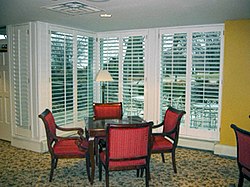Window shutter
This article needs additional citations for verification. (September 2014) |

A window shutter is a solid and stable window covering usually consisting of a frame of vertical stiles and horizontal rails (top, centre and bottom). Set within this frame can be louvers (both operable or fixed, horizontal or vertical), solid panels, fabric, glass and almost any other item that can be mounted within a frame. Shutters may be employed for a variety of reasons, including controlling the amount of sunlight that enters a room, to provide privacy, security, to protect against weather or unwanted intrusion or damage and to enhance the aesthetics of a building.
Depending on the application, and the construction of the window frame, shutters can be mounted to fit within the opening or to overlap the opening. The term window shutter includes both interior shutters, used on the inside of a house or building, and exterior shutters, used on the outside of a structure. On some styles of buildings it is common to have shutters to cover the doors as well as the windows.[1]
Interior shutters


Interior shutters are typically divided into narrow units hinged accordion-style so that two or more units cover each side of a window opening when closed. Operable louvered shutters have louvers (or louvres in British usage), or slats, controlled by a tilt bar or rod to adjust the louver position and keep them in a uniform position, to control light, visibility and airflow. Shutters with operable louvers are described variously as traditional shutters, California shutters, or plantation shutters. Plantation shutters, typical of hot lower latitude climates like
Other interior shutters use stationary louvers that do not rotate (fixed louvers); solid raised or flat panels; fabric inserts; or tinted glass. Shutters can be configured in a single tier unit that has one shutter top to bottom of a window opening as well as multiple tiers. Multiple tier units feature separate shutters on each tier which allows the top shutters to be opened independently from the bottom shutters. Café-type shutters refer to shutters that only cover the lower portion of a window.
Full height shutters can be made with a horizontal divider rail which separates the upper and lower portions of the shutter. With operable louvered shutters this gives greater control as the louvers above the divider rail can be operated independently from the louvers below the divider rail. Interior shutters can be constructed from numerous woods, which can be painted or stained, and a variety of synthetic materials. Interior shutters that are made to close tolerances are preferable for the best possible fit. When louvers or tilt bar (rod) become damaged, replacement kits for these damaged parts may be ordered online and are easy to install.
In the UK, most interior shutters historically were paneled.
Exterior shutters




Exterior shutters were originally constructed for light control, privacy, security and protection from the elements. Many areas of tropical Australia, the Mediterranean, Africa, and the American South, feature exterior shutters that block the strong sun from windows. Functional shutters hinge on each side of a window or at the top and swing closed when necessary and can also be mounted on tracks applied to the face of the building.
Certain hardwoods currently used for exterior shutters, specifically
Exterior shutters in France, notably in Paris, are frequently made of steel and are configured in multiple narrow full-length panels, allowing them to fold open and fit inconspicuously against the recesses at the sides of the window. Some exterior shutters in Italy, such as in towns along the Adriatic coast, slide on rollers into pockets in the wall at each side of the window.
In Germany and other parts of Europe, rolling exterior shutters on tracks (de) have become ubiquitous. When open, these type shutters roll up into boxes concealed in the thickness of the wall above the window. They are typically raised and lowered manually, such as by a rolling pull made of flat nylon cord, but they can be equipped with electric operating mechanisms. These shutters allow some light in the room when not fully lowered, but wholly block light when completely closed. Variations include frame extensions that allow the closed shutter to swing out like an awning or Bermuda shutter.
An exterior
See also
- Robotic window cleaner
- Roller shutter
- Window blind
- Window treatment
- Window shutter hardware
References
- ^ Hearst Magazines (1988-12-01). Popular Mechanics. Hearst Magazines.
- ^ Velez, Adriana (2019-10-05). "How Much Do Plantation Shutters Cost, and How Do They Pay Off?". Realtor.com. National Association of REALTORS and Move, Inc. Retrieved 2021-03-31.
- ^ Longstaffe, Caroline (2020-09-28). "The Shutters of Provence". France Today. France Media Ltd. Retrieved 2021-03-31.
External links
![]() Media related to Window shutters at Wikimedia Commons
Media related to Window shutters at Wikimedia Commons
